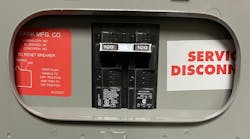All references are based on the 2014 edition of the NEC.
Section 517.19(C)(1) was added to the 2014 edition of the NEC in order to correlate with Sec. 6.3.2.2.6.2 of The Health Care Facilities Code (NFPA 99). Both codes now require operating rooms to have a minimum of 36 receptacles. This is a smart idea due to the amount of equipment that is likely to be used during an operation. But when it comes to figuring out the requirements for the branch circuits supplying power to these receptacles, it’s not so clear as to how many receptacles, if any at all, need to be connected to the critical branch of power.
Section 517.19(C)(1) of the NEC states that at least 12 of these 36 receptacles must be connected to either a normal power branch circuit or a critical power branch circuit. What about the other 24? Could they also be connected to a normal power branch circuit? The NEC simply doesn’t say what circuits to connect the other 24 receptacles to. That could potentially lead to all of these remaining receptacles being connected to normal power circuits — with none being connected to the critical branch power.
I’m not so sure that is the intent of either code in this particular case. However, the literal wording could allow this to happen. This would be especially bad for the patient on the operating table if the power were to go off during the middle of an operation. I don’t think the lawyers representing the health care facility would prefer this situation either. Perhaps a deeper look into the Health Care Facilities Code could help clarify things a bit.
Section 4.1.1 of NFPA 99 states, “Activities, systems, or equipment whose failure is likely to cause major injury or death of patients, staff, or visitors shall be designed to meet Category 1 requirements as detailed in this code.” Section 6.3.2.2.1.2 of that same code then requires Category 1 spaces to be served by circuits from a critical branch panelboard plus a minimum of one normal power circuit or another critical branch circuit originating from a different transfer switch. While this does not specifically address which circuits to connect the receptacles to, I believe the intent is to allow some of the operating room receptacles to continue to provide power in the event of a loss of power from the normal power source. Of course, it’s always best to check with your AHJ whenever you have any questions regarding interpretation of a code requirement.





